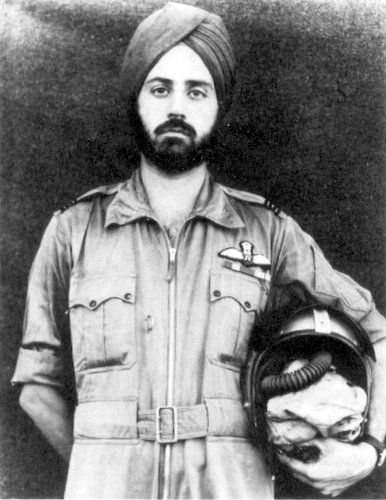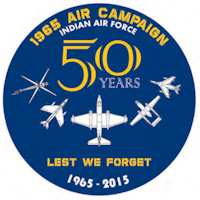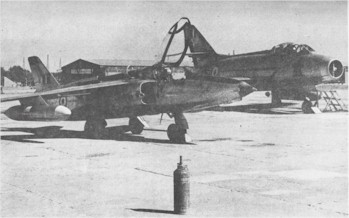The story of tank busting by a Mystere Squadron in the Chamb sector as told by Air Marshal Trilochan Singh

Introduction
By the end of 1964 I was back with a Mystere Squadron at Pathankot, No. 3 Squadron (“Cobras”) having been equipped from Ouragans to Mysteres to Ouragans and now back to Mysteres. Tough grossly underpowered, the Mystere IVA was a powerful anti-armour platform. Carrying two rocket pods of 68mmX38 hollow charged rockets that could only be fired in a salvo. These were carried under the wings but another 55 of this RPs could be carried in the belly in lieu of a 100 gal fuel tank. Once the target was in gun sight it had little chance of escape as the hollow-charged head pierced through the armour plating and exploded inside with catastrophic consequences.
By early 1965, after the Rann of Kutch fiasco, it was obvious that we were heading for a showdown with Pakistan and war clouds loomed large on the horizon. By July, flying activity increased substantially and each of us putting in 2-3 sorties per day on regular basis. No.3 squadron was commanded by Wg Cdr Paul Roby with whom I had served earlier and knew closely.
The Kashmir valley had been closed for operations by combat aircraft I believe sometime after the December 1948 ceasefire. I was therefore quite surprised when the CO (Paul Roby) called me in his office one morning in the third week of August 1965 to say that he and I as his No.2 would fly a two aircraft mission into the valley as a sort of flag showing. We went in at low altitude and flew along the valley, over Srinagar and beyond in wide circles and returned to Pathankot when the fuel hit the bingo figure. I then concluded that things were hotting up indeed. I was only a Flt Lt, not party to briefings at higher level and therefore left to my own surmising. Induction of a Vampire squadron to the base in addition to the two Mystere squadrons already based made matters amply clear. The problem was that the blast pens on the base were just adequate for the Mysteres and the Vampires hence remained parked neatly in a straight line on the main tarmac. Juicy target indeed!
The first day at Chamb
 Tension was high from early morning on 1st September 1965. All the aircraft were loaded with the operational rocket pods. Additional qualified Mystere pilots from Training Command were attached and had reported the previous day. I had been flown out to Palam in an Otter at night to fly one night sortie in a Hunter and brought back by early morning and declared night-qualified “fully operational”! We did not have a single night qualified till then. As I have said, tension was running high but nothing was happening -just waiting and marking time- a repeat of what I had gone through at Tezpur with No.29 squadron on Ouragans in 1962. Finally at about 1700hrs, the CO was ordered to report to the ops room with three of his pilots for immediate briefing. Gp Capt Roshan Suri, the station commander painted a grim situation of our army’s position at Akhnoor and the Pak armour’s thrust at Chhamb on the river Tawi (near Jammu). Maps were quickly marked with the GLO giving the overall operational situation on the Tawi. The plan was to launch 12 Vampires in three formations to open the air attack to be followed by our Mystere formation (4 aircraft) and then one more similar formation led by Wg Cdr Goodman. It did seem very odd that the Vampires had been selected to open the innings!
Tension was high from early morning on 1st September 1965. All the aircraft were loaded with the operational rocket pods. Additional qualified Mystere pilots from Training Command were attached and had reported the previous day. I had been flown out to Palam in an Otter at night to fly one night sortie in a Hunter and brought back by early morning and declared night-qualified “fully operational”! We did not have a single night qualified till then. As I have said, tension was running high but nothing was happening -just waiting and marking time- a repeat of what I had gone through at Tezpur with No.29 squadron on Ouragans in 1962. Finally at about 1700hrs, the CO was ordered to report to the ops room with three of his pilots for immediate briefing. Gp Capt Roshan Suri, the station commander painted a grim situation of our army’s position at Akhnoor and the Pak armour’s thrust at Chhamb on the river Tawi (near Jammu). Maps were quickly marked with the GLO giving the overall operational situation on the Tawi. The plan was to launch 12 Vampires in three formations to open the air attack to be followed by our Mystere formation (4 aircraft) and then one more similar formation led by Wg Cdr Goodman. It did seem very odd that the Vampires had been selected to open the innings!
The take off and navigation to the target area went as planned and in the outbound I saw the last Vampire formation of 4 intact and homeward bound. RT silence precluded any reporting. It was a short trip to the target and as we pulled up from low level, the sight of Patton tanks everywhere was awesome. They were out in the open with no camouflage and all that was needed was to pick the one that an accurate dive angle and tracking time for the gun sight for a certain kill. The problem was all the RPs were fired in a salvo on the first pass but the sight of the tank blowing up was unforgettable – the first time that I fired in anger. I now had only gun ammo to hammer the support soft skinned vehicles but that too for one pass only as the airspace had to be vacated for the following formation behind us.
The feeling on the home leg was that of exhilaration. What an easy turkey shoot! The only thing I could not explain to myself were some black spots whizzing past the cockpit in the dive. Only after landing did I realize that they were machine gun tracers being fired from the tanks at the aircraft. Some of the light ammo caused minor damage to the aircraft skin.
I was in high spirits after what I considered had been a fruitful mission and proceeded straight to the wing ops room for the mission debrief along with the C.O. along with other formation members. On reaching we found the mood somber with general sadness in the air only then did the cause did the cause for it become clear. We had lost 4 Vampires out of the 12 launched, one from the first formation and three from the second, shot down by PAF Sabres. It was obvious that the PAF had left the tactical area earlier either owing to our arrival or lack of fuel that is how the last Vampire formation had survived intact.
The question now was planning for the next days. The Vampire squadron was withdrawn immediately and it was decided to induct a flight of Gnats from No.23 squadron to give top cover to the Mysteres so that we could concentrate entirely on our primary mission of ground attack. Till such time as the Gnats actually made their appearance, we cleaned up the Mysteres for high speed reconnaissance of the battle area. In its clean configuration could easily clock 600 Kts at which speed the Sabers would hardly get into gun firing position.
 |
A Folland Gnat fighter with a Mystere IVa. Mysteres escorted by Gnats wreaked havoc on the Pakistani army formations in Chamb. These particular aircraft are from Adampur. |
The next days, upto 5 September were very satisfactory for our attacks on enemy armour, vehicles and troop concentrations. With Gnats giving top cover, our ground attack missions were highly effective and there are three missions which I recall vividly. The first when I was over the Chhamb area at very low altitude (Under 50ft) and suddenly flew over a Patton tank, too late for an effective attack. I made a wide circuit and came back but by the time I had relocated the tank, I was not settled in the dive. As I closed in to my surprise and satisfaction, saw the crew had abandoned their tank and were running away. I was so close that I could virtually see the terror on their faces. Sure that my target was static, I could take my time for a bullseye as if on a practice firing range. After this tank was blown up. I spotted another in a pond of water that too was a dead duck.
I once got separated from the rest of my formation owing to RT channel error. However two escorting Gants and I were on the correct one and in contact. Hence I decided to carry on alone and found very large numbers of soft skin vehicles near some tanks. After firing the rockets, I went in with my cannon, one short burst each pass to conserve ammo and made about 0-10 such passes till such time as the Gant leader (my course mate Mana Murdeshwar) called to say that they were running very low on fuel, and so made a quick last pass, really satisfying to see the vehicles brewing up one after another.
On the night of 5th September 1965, at about midnight, I was in the ops room awaiting target allocation for the next morning, a signal arrived to state that the Indian Army was opening up the whole western front in Punjab and Rajasthan to relive pressure on the Jammu front the following morning, 6th September 1965. Very strangely, the same signal also ordered that enemy airfields were not to be attacked. It was hard to understand such a decision and I was certain that no such restraint would be exercised by the P.A.F. so early next morning I bundled off my family for safety to Delhi by road, ready for an all out war. Full attention would be focused on planning and operational flying in the war ahead.
September 6th : Raid on Pathankot
As expected. Pathankot got full attention of the PAF on 6th September evening. I was leading a four aircraft formation and had just touched down when I heard a voice on RT informing ATC that the radar unit at Amritsar was reporting a large formation of aircraft from the west heading towards Pathankot. Fg Offr Mike McMahon who had been launched in his Mystere to become the voice link between Amritsar radar and Pathankot ATC as all landlines were unreliable. My two Gnat escorts had landed first as they were low on fuel.
At the end of my landing run, I taxied to the designated blast pen and an airman placed the ladder and came up to take my helmet and assist in unstrapping. Just then I looked up to see what seemed like 8 Sabres positioning themselves to dive on our aircraft parked in the open. I too was parked in the open just outside the blast pen, and was sure I would get some attention from the PAF. I saw a Sabre diving towards me at a range of about 800mts but not fully settled and still banking for alignment. My first reaction was to push my airman off the ladder to save him somewhat and the to sit tight in the cockpit hoping that the unsettled dive of the attacking aircraft would make him miss. And that is what actually happened; his 6 x 0.5 bullets sprayed the ground from about 10ft in front kicking up a lot of debris but recording not hits on my aircraft. As he passed overhead, I jumped down without the ladder and ran to the nearest bunker to helplessly watch the attacks.
The Sabres continued their attack for about 7-8 minutes and I could see aircraft fires all around. There was some sporadic ack-ack firing by our guns but to no effect and then the attackers set course westwards. I stood up to take stock, with thick clouds of black smoke all around and the odd cannon shells and rockets going off owing to the heat of the fire. The final count of our losses: 5 Mysteres, 2 MIG-21, 2 Gnats (my escorts) and one packet transport aircraft. What a Tally!.
That night as the moon came out to provide minimum light conditions PAF B-57 bombers started their runs, one aircraft at a time but at regular intervals. The damage caused was not significant, except we could not get much sleep, shunting between our beds and the trenches. Form 7th September onwards, No.3 squadron continued with close support and anti armour missions but were not assigned the task of attacking PAF airfields which was left to the Mysteres and Hunters from Adampur and Halwara.
It was on 8th September that I carried out what turned out to be a very successful mission. In an attack north of Lahore against artillery positions, I was about to release my RPs when I saw a well camouflaged cluster of tents and what looked to be an important headquarters of an army formation. I called off that attack and made a wide circuit for a second pass, giving enough time to reacquire the camouflaged headquarters and make an accurate strike. The whole camp blew up spectacularly. When I reported to the ops room, it was confirmed from radio intercepts that this PAK army formation had suffered a major blow, whether it was Division or Brigade headquarters. There were no further PAF day fighter strikes on Pathankot after the one on 6th September but the B-57 came every evening, his raid time determined by the moon rise. Accordingly I fell into a routine of being already in a comfortable trench with a bottle of beer and my transistor radio. Listening to the progress of the war on All India Radio. I was in this trench on the night of 10th September that I heard of gallantry award winners, my name included! I was not aware that I had been recommended for a VrC. The others in our squadron awarded were Wg Cdr S.Bhattacharya, the new C.O. and Flt Lt Doriaswamy. I felt that I had made my contribution to the war effort, having flown the maximum number of missions in No.3 squadron besides being actively involved in the planning of many more.
Acknowledgements:
Vayu Aerospace Review in which the Article originally appeared.
Philbert Periera for transcribing the article.
Copyright © Vayu Aerospace Review . All rights reserved. Reproduction in whole or in part in any form or medium without express written permission of © Vayu Aerospace Review is prohibited.